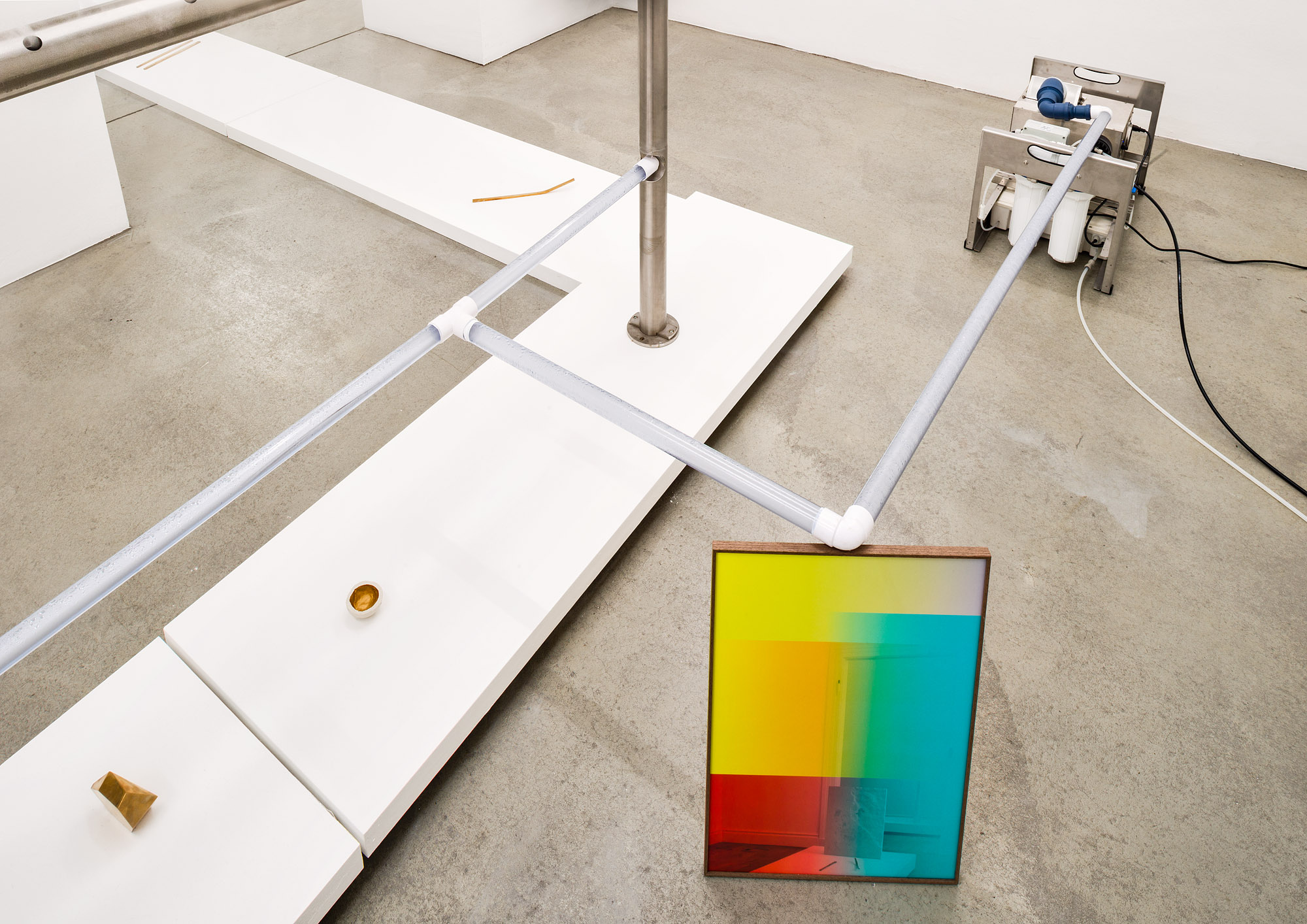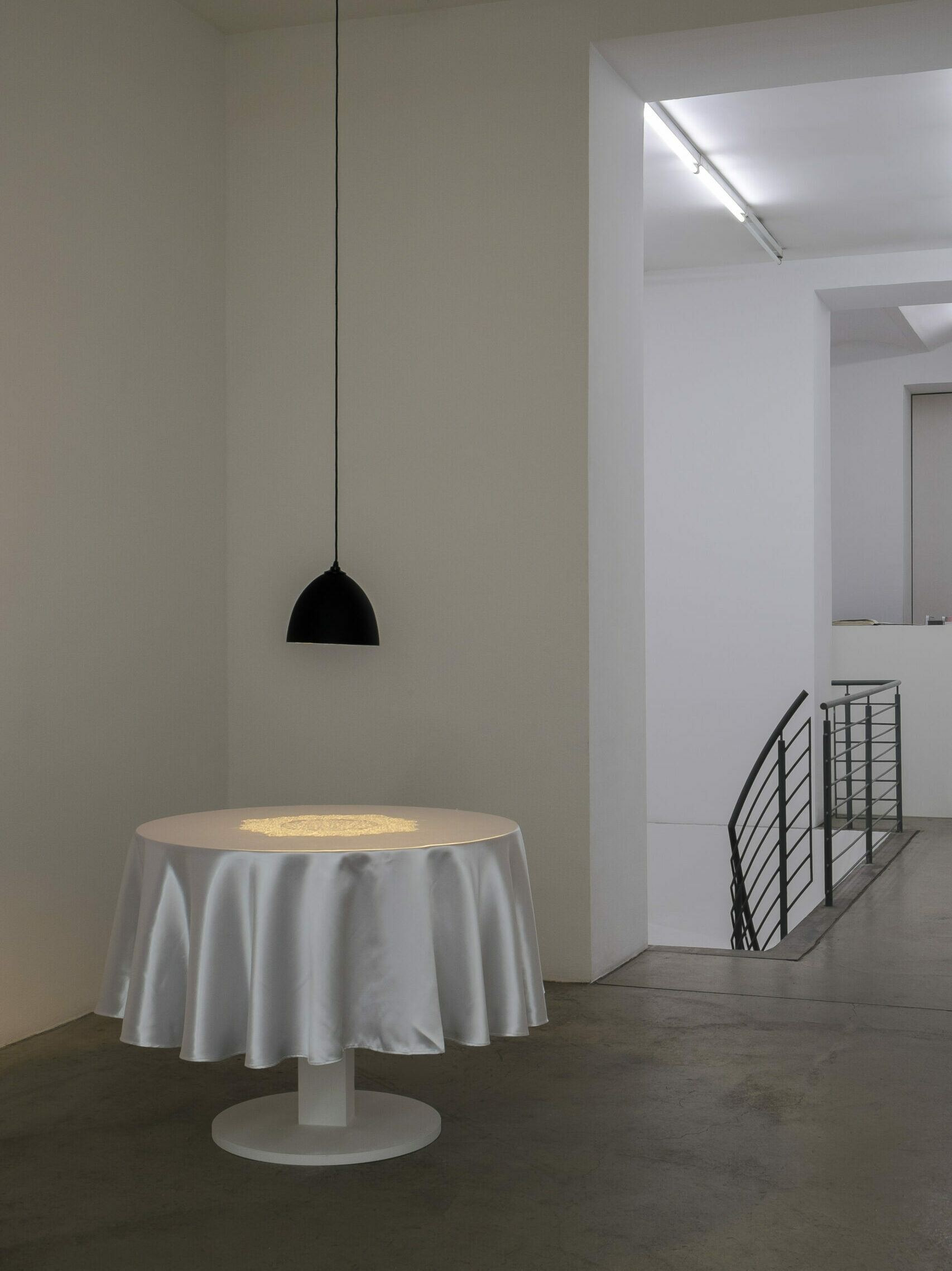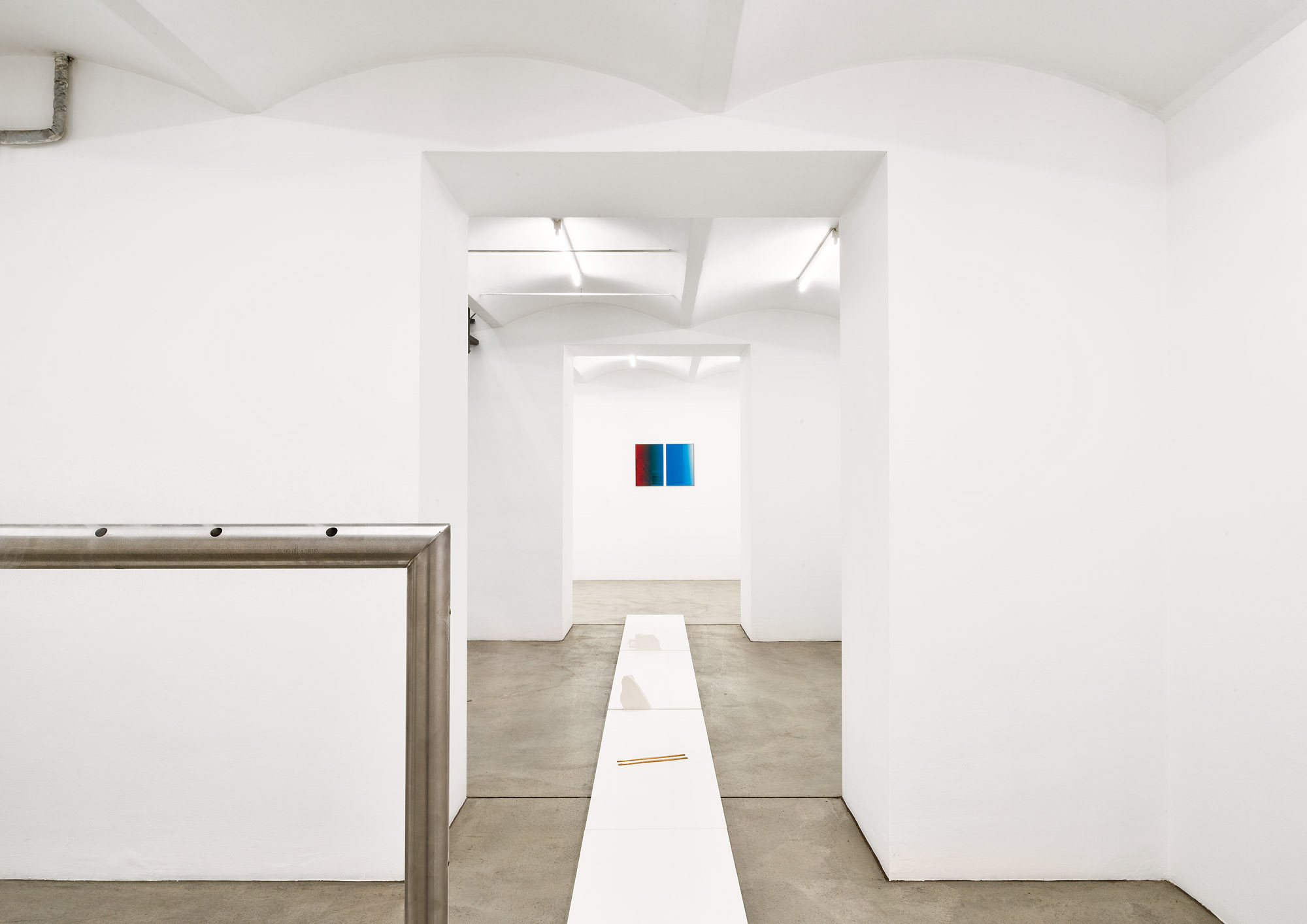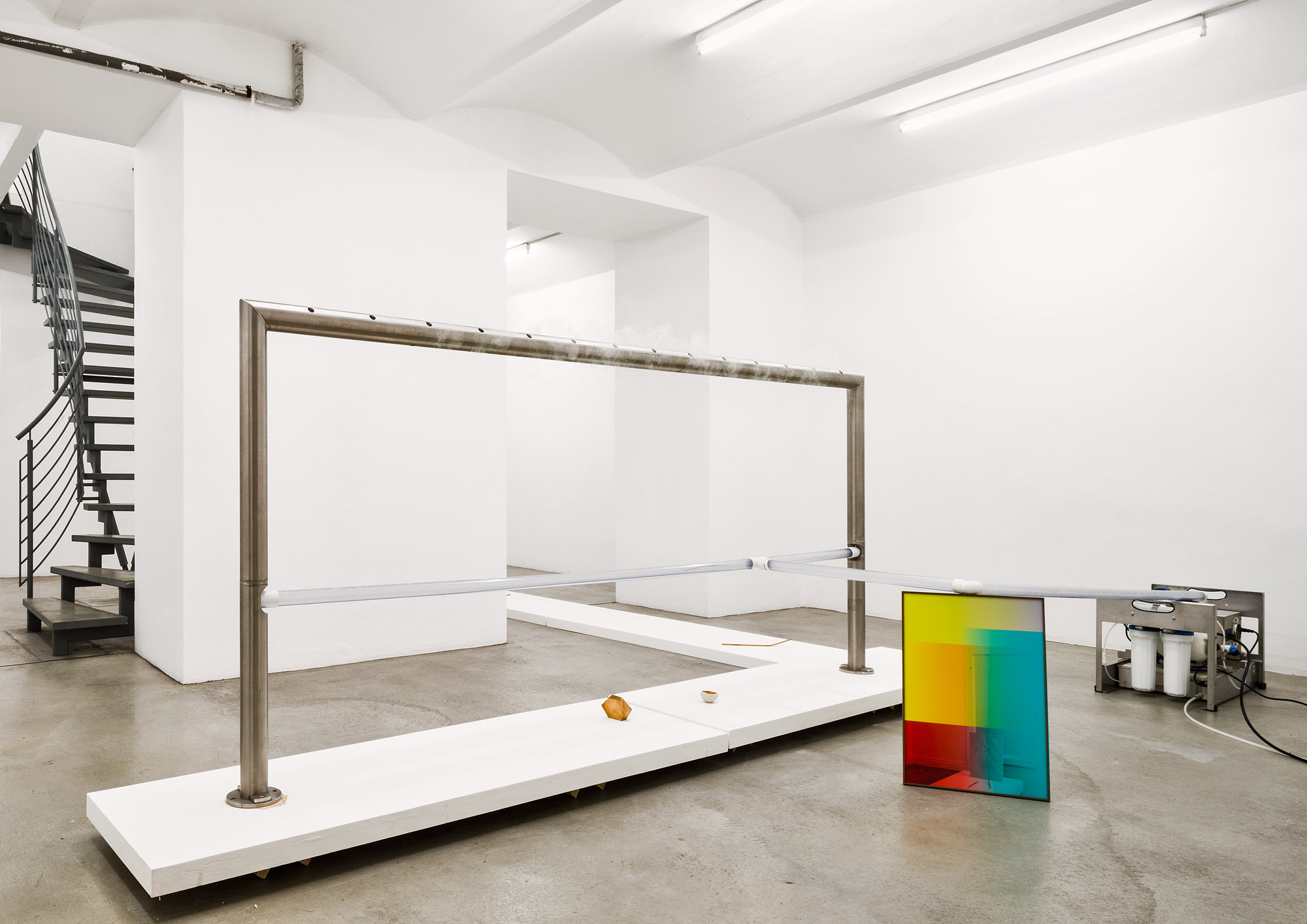
Saskia Noor van Imhoff
#+14.11, 2013
A2 c-print, Luftbefeuchter
THE CENTURY OF THE BED – curated by Dirck Möllmann
Das kleine i | The small i
James Cabot Lana Čmajčanin Saskia Noor van Imhoff Paul Etienne Lincoln

Lana Čmajčanin
166987 Pricks, 2013
Tischdecke, Seide, Stickerei, Seidenstickereigewinde
50 cm Ø, 170 cm Ø

Paul Etienne Lincoln
In Tribute to Madame de Pompadour
and the Court of Louis XV, 1982–1991
Das Bett ist ein Gegenort der Arbeit. Inaktiv. Wir ruhen, unser Körper arbeitet ohne uns. Wärme, Verdauung, Erholung. Wir träumen. Das Unbewusste arbeitet mit uns. Wir machen Liebe. Das Weitere geschieht von allein. Wir brauchen das Bett, es setzt uns außer Kraft. Das Bett fordert keine Entscheidung zwischen aktiv und passiv, zwischen Ja und Nein, es nötigt zu keinem Sinn. Es schafft andere Zustände. Wir schlafen, wir sterben im Bett. Das Bett ist mehr als ein Gegenort. Indem es Arbeit und Nichtstun in sich vereint, suspendiert es den täglichen Konflikt um Bedeutung und die unablässige Arbeit am Sinn – das Bett ist wie ein Neutrum. Es lässt die Zeit stillstehen. Ein leidenschaftlicher Ort, ein Zustand der Inbrunst, eine Intensität der Erschöpfung. In tiefem Vertrauen. Im traumlosen Schlaf. Zu zweit, allein. Auf den Schlaf folgt ein Erwachen. „Ich schlafe immer, ich brauche Zeit, um aufzuwachen, um zu begreifen“, sagte der sterbende André Gide. Sein Erwachen umschreibt ein spätes Verstehen in der Zeit. Langsam begreifen. Wortlos. Voller Bilder. Die Ausstellung Das kleine i könnte auch Das kleine n wie Neutrum heißen oder Das kleine a wie das Objekt klein a. Das kleine i meint den Zustand, außer Kraft gesetzt zu sein, nutzlos, inaktiv und zugleich empfänglich für andere Signale der Kommunikation. Eher wie ein Rauschen im unsteten Begehren einer „potentia passiva“. Ein Zustand der Schwebe, ähnlich der Kunst, in einem Zartgefühl, das zu nichts dient (Barthes).
Die hier versammelten Werke stammen von zwei Generationen von Künstlerinnen und Künstlern sowie aus verschiedenen Zeiten. Keines von ihnen bezieht sich auf das Bett als Motiv. In jedem von ihnen lässt sich dieser besondere Zustand auffinden, außer Kraft gesetzt und zugleich empfindsam zu sein. Sei es durch Abwesenheit wie bei dem delikaten und in Auflösung begriffenen Vakuum bei Paul Etienne Lincoln, als Präsenz einer einschnürenden Leseerfahrung bei Lana Čmajčanin, im faszinierenden Formmaterial der kollektiven Zeitgestalten von James Cabot oder in jenem eleganten Schwebezustand des Sehens und Verstehens in den Installationen von Saskia Noor van Imhoff. In jeder Arbeit verkörpert sich die unmögliche Möglichkeit der Kunst. Und darum geht es ja schließlich.
Paul Etienne Lincoln widmete der Madame de Pompadour eine komplizierte Apparatur, die ihn über neun Jahre in Anspruch nahm (In Tribute to Madame de Pompadour and the Court of Louis XV, 1982-1991). Das funktionsfähige Gebilde symbolisiert den absolutistischen Hofstaat unter Kontrolle des Königs. In seiner Mitte erzeugt es ein Vakuum, stellvertretend für Madame de Pompadour, die berühmteste aller Mätressen. Zwei Lebewesen existieren darin – Bienen produzieren Honigsirup und Schnecken sorgen für den Abfluss in eine komplexe Kalziumkammer, die Wasser in Gas verwandelt, um das Vakuum zu erzeugen. Der gesamte Court war für seinen langsamen und absehbaren Zusammenbruch gebaut worden. Die Performance wurde zweimal aufgeführt, 1984 am Royal College of Art und 1985 in Cambridge bei Coracle Press. Zu sehen sind Zeichnungen, Dokumente und ausgegliederte Editionen des ursprünglichen Werks.
Lana Čmajčanin stickte mit 166987 Einstichen (166987 Pricks, 2013) und silbrig schimmerndem Faden Aussagesätze in ein Tischtuch, die sich nur langsam entziffern lassen. Das englische „prick“ meint Stich im durchaus vulgären Doppelsinn. Čmajčanins Text lässt eine Schleife scheinbar hemmungsloser sexueller Übergriffe und Wünsche entstehen, die Lust erwecken und Situationen öffentlicher Rede so schildern, dass die Scham wie ein Kloß im Halse stecken bleibt. Auf doppelbödige Weise reflektieren Text, Präsentation und Materialien die immer wiederkehrenden sexuellen Hierarchien, Zumutungen und Rollenzuweisungen an Frauen im Kunstsystem. Čmajčanin interpretiert das Verhältnis von Werk, Produzentin und Betrachter als eine öffentliche Schaustellung. Ihre vielen Einstiche formen einen Gegen-Ort zum Kunstbetrieb auf ebenso imaginative wie materielle Weise und durchleuchten nonchalant die ihm innewohnenden Regeln.
Fünf in sich ruhende Objekte hat James Cabot mit Schablonen in feuchten Ton geformt (Clay Pots, 1990). Ihr Profil entspricht den Bevölkerungsstatistiken Deutschlands zwischen 1910 und 2033, unterschieden nach männlichen und weiblichen Bevölkerungsanteilen. Lateinisch Statisticum heißt „den Staat betreffend“. Die Wölbungen der Tonskulpturen formen also den statistischen Kollektivkörper der sexuellen Reproduktion ab. Ihre Reihung im Abstand von ungefähr einer Generation (1910 – 1939 – 1959 – 1986 – und dann mit größerem Abstand die Prognose für 2033) lässt die Zeit als eine sinnlich erfahrbare Gestalt wahrnehmen. Die Formen finden im Objekt weich gleitende Übergänge und wachsen bizarr von einer nahezu gleichmäßigen Pyramide zu Beginn des 20. Jahrhunderts, hier in die Form eines dreidimensionalen Kegels übertragen, durch historische Katastrophen, Einschnürungen und Deformationen in eine knorrig ausstehende Zukunft.
Die Installationen von Saskia Noor van Imhoff bestehen aus Rückverweisen, Materialspuren, Farben und Bildern von ausgesuchter Eleganz, die persönliche Dinge ebenso wie Gegenstände aus Archiven von anderen und eigenen Kunstwerke enthalten. Die Werke werden mit einer fortlaufenden Zählung betitelt. Fragen an die Wirklichkeit der Dinge, an ihren Inhalt, werden so in künstlerische Form und Systematik übertragen und aus einer einfachen Referenz entlassen. Es ist so wie es ist. Fein gesponnen entsteht mit der Zeit ein sich langsam erweiterndes, in sich selbst zurücklaufendes Netzwerk. Imhoff arbeitet für ihre Präsentationen auch mit dem Raum, den sie mal aktiviert oder unzugänglich still legen kann. Ihre offene Verweisstruktur im Werk interessiert sich mehr für Fragen als Antworten. Wenn alles gelingt, steht im Keller eine Maschine, die von Zeit zu Zeit kühlenden Nebel produziert.
Die hier versammelten Werke stammen aus zwei verschiedenen Generationen von Künstlerinnen und Künstlern sowie aus verschiedenen Zeiten. Jeder Künstler folgt einem eigenen Begriff von Skulptur oder Installation. Keiner von ihnen bezieht sich auf das Bett als ein Motiv. In allen Werken lässt sich der besondere Zustand der Kunst, außer Kraft gesetzt und zugleich empfindsam zu sein, auffinden. Sei es durch Abwesenheit wie mit diesem delikaten und in der Auflösung begriffenen Vakuum bei Paul Etienne Lincoln, das Madame de Pompadour, die berühmteste aller Maitressen, symbolisiert. Sie war eine äußerst ehrgeizige Frau des 18. Jahrhunderts, die mit ihrer Macht am Hofe Ludwigs XV unter anderem für den Einfluss auf Strategien der Kriegsführung und für kulturelle Förderung eingesetzt hat. Lana Čmajčanin verschiebt die Perspektive der Machtverhältnisse von einer imperialen Maitresse auf die Rolle der Künstlerin als einer öffentlichen Frau und sexualisiertes Objekt. Ihre Bühne ist weniger das Bett als das Betriebssystem Kunst. Das faszinierende Formmaterial der kollektiven Zeitgestalten von James Cabot zeigt, für diesen Anlass hier grob vereinfacht gesagt, die Ergebnisse der Arbeit einer Bevölkerung im Bett, getrennt nach Weiblich (linke Hälfte des Tonobjekts) und Männlich (rechte Hälfte des Tonobjekts). Der elegante Schwebezustand des Sehens und Verstehens in den Installationen von Saskia Noor van Imhoff verweist auf das Bett nur mehr als Andeutung. Ihre Maschine im Keller arbeitet wie ein Körper wie das Unbewusste unablässig und beeinflusst die Wahrnehmung des Raums als einer Gesamtinstallation, die auf das Archiv, die Erinnerung und der Kunst als Ausstellung anspielt. Der gesamte Galerieraum hat sich in einen dem Bett ähnlichen Zustand der Inaktivität verwandelt, kurzzeitig unterbrochen von Aktivitäten. In jeder dieser Arbeiten verkörpert sich die unmögliche Möglichkeit der Kunst. Und darum geht es schließlich.
Dirck Möllmann (* 1963) ist Kurator am Institut für Kunst im öffentlichen Raum Steiermark, Universalmuseum Joanneum, Graz.

James Cabot
Clay Pots, 1990
5-teilig
je 50 cm
The bed is a counter-space for work. Inactive. We rest, and our bodies work without us. Warmth, digestion, relaxation. We dream. The subconscious works on us. We make love. Everything else happens of its own accord. We need the bed; it allows us to become inoperative. The bed demands no decision between active and passive, between yes and no; it does not compel us to make sense. It makes room for other states. We sleep, we die in bed. The bed is more than a counter-space. By bringing together work and inactivity, it suspends the daily conflict centered around meaning and the ceaseless quest for meaning—the bed is like The Neutral. It makes time stand still. A passionate place, a state of fervor, an intensity of exhaustion. With deep trust. In dreamless sleep. As a pair, or alone. Following sleep is an awakening. “I always sleep, I need time to wake up, to understand,” said André Gide on his deathbed. His awakening circumscribes an understanding delayed in time. Slow to understand. Wordless. Full of images. The show The small i could also be called The small n like The Neutral, or The small a like the object small a. The small i refers to the state of being inoperative, useless, inactive, and simultaneously receptive to other signals of communication. More like the static in the erratic yearning for a potentia passiva. A state of limbo, similar to art, in a delicacy of feeling that serves no end (Barthes).
The artworks collected here originate from two different generations of artists, and also from different periods. None of them treat the bed as a motif. Discernible in each work is this special state of being inoperative and open to the senses at the same time. Be it through absence, as in the case of this delicate vacuum caught in a state of dissolution in the work of Paul Etienne Lincoln (on view are drawings, documents, and excluded editions of the original work); through the presence of a constrictive reading experience in Lana Čmajčanin’s works; in the fascinating form-related material of collective temporal forms by James Cabot; or in the elegant, abeyant state of seeing and understanding in the installations of Saskia Noor van Imhoff. Embodied in each of these works is the impossible possibility of art. And that is what ultimately matters.
Paul Etienne Lincoln spent nine years working on a complicated apparatus which he dedicated to Madame de Pompadour (In Tribute to Madame de Pompadour and the Court of Louis XV, 1982–91). This operational construct symbolizes the absolutist royal court as subject to the king’s authority. At its center a vacuum is generated, vicariously representing Madame de Pompadour, the most famous of all mistresses. Two creatures reside inside: bees producing honey syrup and snails facilitating drainage into a complex calcium chamber where water is turned into gas in order to generate the vacuum effect. The entire Court was designed and built to slowly collapse. This performance was carried out twice: at the Royal College of Art in 1984 and in Cambridge at Coracle Press in 1985. On show in the present exhibition are drawings, documents, and excluded editions of the original work.
Lana Čmajčanin embroidered messages into a tablecloth with 166,987 pricks of the needle (166987 Pricks, 2013) using lustrous silver thread, with the messages being difficult to decipher. The English word “prick,” used here to denote stitching, is absolutely intended to evoke a vulgar double meaning. Čmajčanin’s text fosters a loop of seemingly uninhibited sexual encroachment and desire, thus arousing passion and rendering situations of public speech in such a way that shame causes a lump in one’s throat. Text, presentation, and materials ambiguously reflect the perennial sexual hierarchies, unreasonable demands, and role allocations to which women in the art world are subjected. Čmajčanin interprets the relationship between work, the (female) creator of art, and the beholder as a public exposition. With an approach that is imaginative and material in equal measure, her many pricks give rise to a counter-site within the art world and nonchalantly illuminate its intrinsic rules.
James Cabot crafted five quiescent objects from moist clay with the aid of stencils (Clay Pots, 1990). The objects’ profiles reflect demographic statistics from Germany between 1910 and 2033, differentiating between male and female population segments. The Latin word statisticum means “pertaining to the state,” so the curves of the clay sculptures reflect the collective statistical body of sexual reproduction. By sequencing them in intervals of about one generation (1910 – 1939 – 1959 – 1986 – and then the prognosis for 2033 in longer intervals), a shape of time may be experienced by the senses. The forms encounter gently flowing transitions in the object and bizarrely grow into a gnarled and pending future from a nearly uniform pyramid in the early twentieth century, here assigned the form of a three-dimensional cone, by way of historical catastrophes, constrictions, and deformations.
The installations by Saskia Noor van Imhoff are made up of cross-references, traces of materials, colors, and images of choice elegance that accommodate personal items but also objects from archives containing her own artwork and that of others. The works are titled with consecutive numbers. Questions regarding the reality of the items and their content are translated into artistic form and classification, thus being liberated from simple referentiality. It is as it is. Over time, a delicately spun web slowly expands and yet returns to itself. In creating her presentations, Imhoff also works with space that she may activate or immobilize to the point of inaccessibility. Its open referential structure within the artwork is more interested in pursuing questions than answers. If all goes well, there is a machine situated in the cellar producing cooling fog from time to time.
The artworks collected here originate from two different generations of artists, and also from different periods. None of them treat the bed as a motif. Discernible in each work is this special state of being inoperative and open to the senses at the same time. Be it through absence, as in the case of this delicate vacuum caught in a state of dissolution in the work of Paul Etienne Lincoln, symbolizing Madame de Pompadour, the most prestigious of all mistresses. She was a very ambitious woman of the 18th century, who influenced the strategy of warfare and gave prominent cultural support with her power at the court of Ludwig XV. (On view are drawings, documents, and excluded editions of Lincolns original work). Lana Čmajčanin shifts the perspective of power relations from an imperial mistress to the function of the femal artist as a public woman and a sexualized object. Her stage is the working system of the art wolrd more than the bed. The fascinating form-related material of collective temporal forms by James Cabot shows, roughly spoken in this context, the results of working in bed by a whole population, separating between female (left side of the clay pot) and male (right side of the clay pot). The elegant, abeyant state of seeing and understanding in the installations of Saskia Noor van Imhoff refers to the bed as a mere allusion. Her machine works steadily in the basement like a body or the unconscious influencing the perception of the space as a complex installation, alluding the archive, memory and art as exibition. The space of the whole gallery has changed into a bed-like condition of inactivity, interrupted by temporary actions. Embodied in each of these works is the impossible possibility of art. And that is what ultimately matters.
Dirck Möllmann (*1963) is curator at the Institute of Art in Public Space Styria, Universalmuseum Joanneum, Graz.



